HP Indigo Printing Adhesive Material
HP Indigo digital printing adhesive material is a printing material that is coated with a special coating on the surface of ordinary adhesive material to increase the adhesion of ink on its surface. For the quality of digital adhesive materials, the uniformity of the special coating on the surface of the digital adhesive material and its adhesion to the surface of the digital adhesive material were mainly examined. Given that there are currently not many domestic users and there is no complete data available for reference in this area, label printing companies usually directly test the color fastness of ink during printing testing to evaluate the quality and final usability of digital adhesive materials
The HP Indigo digital adhesive material certification testing mainly includes the following aspects:
1. Continuous printing performance of materials:
2. Ink transfer performance and transfer quality
3. The adhesion between ink and material, as well as the scratch resistance of ink
4. Reproducibility of highlights, fine line quality, and integrity of image edges
5. Compatibility with rubber blanket, test whether it will produce memory effect of rubber blanket
The wider the temperature setting range of the rubber blanket, the better the compatibility of the material
Weak solvent printing adhesive material
A new type of outdoor solvent based digital inkjet printing method that is popular in the outdoor solvent based digital inkjet market, featuring high safety, low volatility, low to low toxicity, and high flash point. It uses a weak solvent ink, also known as Eco solvent ink or Light solvent ink, for inkjet printing. Weak solvent printing not only maintains the high precision advantage of water-based ink, but also overcomes the disadvantages of rough substrate and images that cannot be used outdoors caused by water-based ink
Weak solvent printing adhesive materials are materials printed with weak solvent ink. The essence of weak solvent ink is a branch of solvent based ink, and its main component is still organic solvents. Low toxicity does not mean non-toxic. Printing in a confined space can cause significant harm to human health
1. Water based printing ink uses coating ink for printing, with zero pollution and emissions in the printing environment, completely odorless, and is the only fully environmentally friendly printing material in the market
2. Water based printing film has high whiteness, good coverage, soft touch, high elasticity, stretch resistance, and good weather resistance. Weak solvent printing film, the finished product has a hard feel, low elasticity, and is prone to folding and cracking in winter weather, with poor weather resistance
The finished water-based printing film has a matte effect, which is naturally harmonious with the fabric material, comparable to silk screen effect, and high-definition and fine than direct spray effect. Weak solvent printing film finished plastic light, friction produces sound. After ironing, the clothes have a thick plastic feel, which is uncomfortable to wear
4. The unique compounding process of water-based printing film can be grafted with special processes such as drawing, flocking, silicone, hot stamping, silver stamping, thick plate, engraving film, etc., to enhance the added value of printing processing. This is not possible with other printing films
5. The water-based printing film is developed based on coating ink and can seamlessly integrate with the pure cotton direct spraying process of printing factories, replacing some white ink and white glue applications

PET adhesive material
It has high tensile strength and tear strength, excellent high temperature resistance and durability, and can be processed into highly transparent, opaque, and metalized films. The surface is coated and suitable for various types of printing and printing, with good automatic labeling ability. Due to its excellent chemical resistance and dimensional stability, it is suitable for indoor and outdoor use
PET label fabrics have important properties such as transparent, bright gold, bright silver, sub gold, sub silver, milky white, sub gloss milky white, and resistance to water, oil, and chemicals. They are used for bathroom products, cosmetics, electrical appliances, mechanical products, and are particularly suitable for information labels on high-tech products
PET series adhesive material list

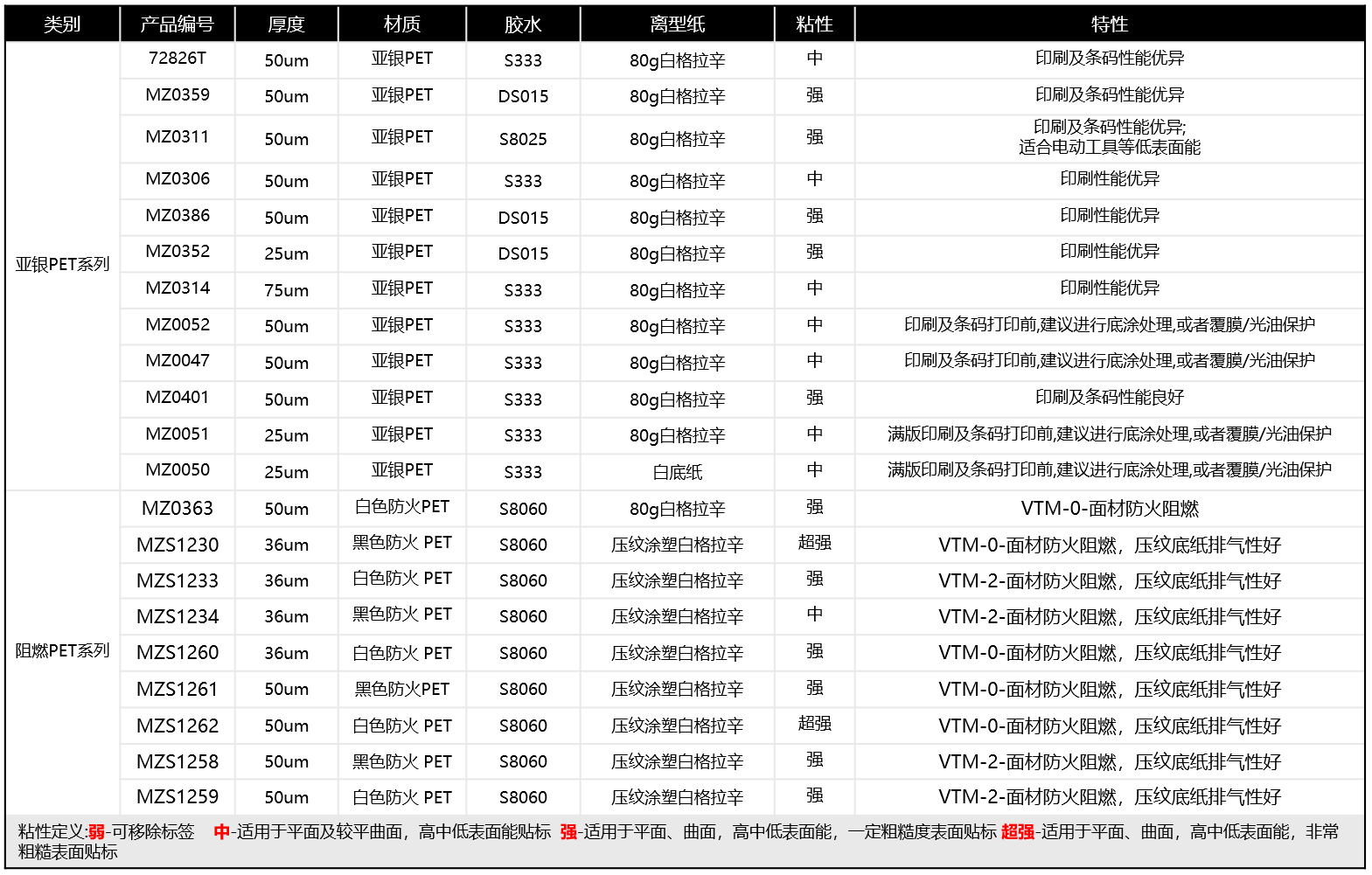
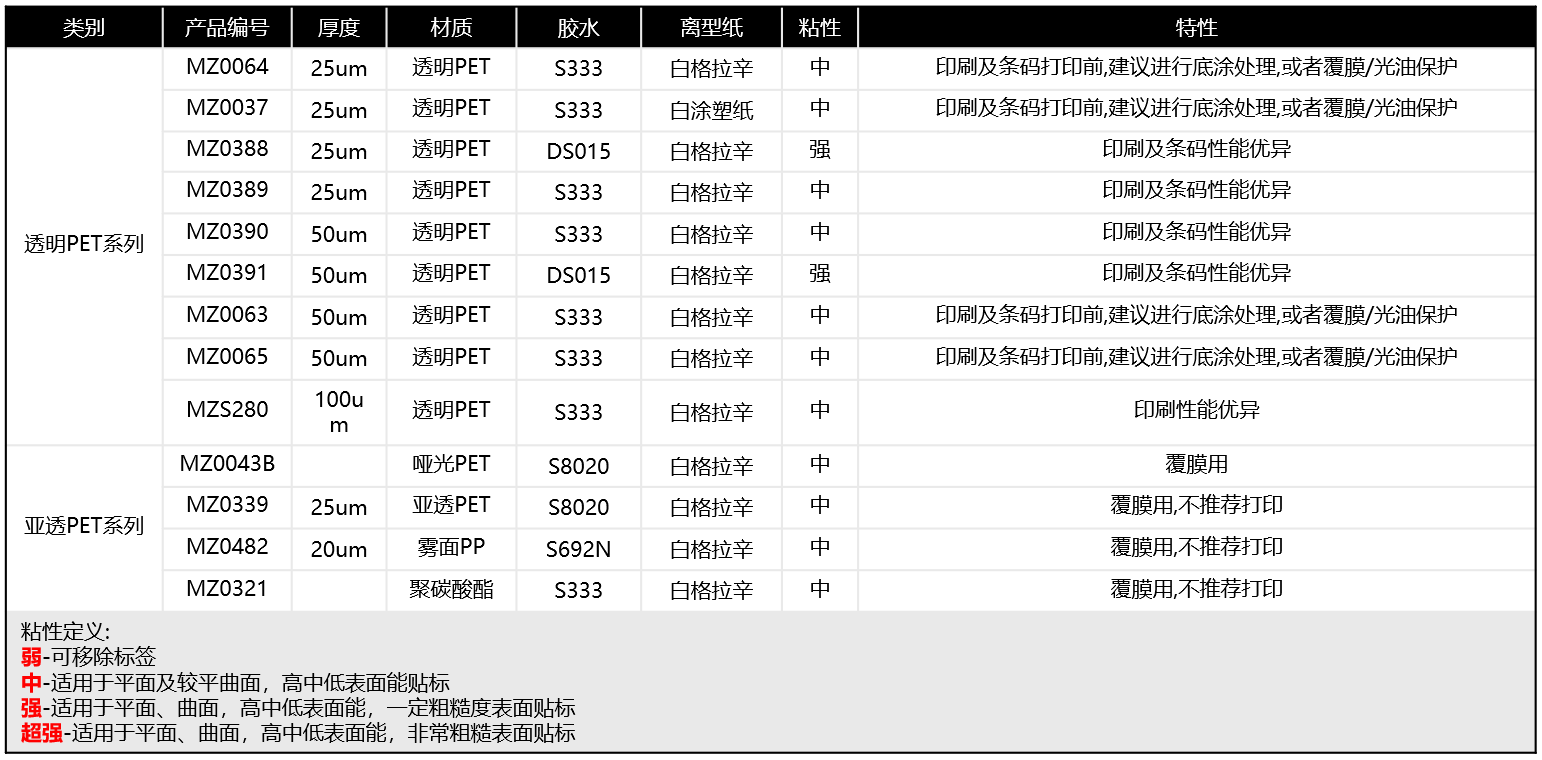
PE adhesive material
PE adhesive label material is an adhesive label made of polyethylene material. They have various advantages, such as water resistance, temperature resistance, scratch resistance, corrosion resistance, acid and alkali resistance, etc. Therefore, they are widely used in scenarios such as goods identification, price tags, price tags, product manuals, valuable item tags, clothing labels, etc. At the same time, when using PE adhesive labels, there is no need to apply water or oil, and they can be directly attached to the surface of objects
Advantages of PE adhesive labels:
1. Strong stickiness: The adhesive of PE self-adhesive labels has high stickiness and can quickly adhere to various material surfaces without easily falling off or shifting
2. Wide applicability: PE adhesive labels can be applied to surfaces of various materials, such as glass, metal, plastic, etc., with a very wide range of applications
3. Corrosion resistance: PE adhesive labels have good corrosion resistance and can resist the erosion of some chemicals, thereby protecting the text and patterns on the label from damage
4. Environmentally friendly and recyclable: PE materials are recyclable and will not cause pollution to the environment, while also conforming to the current trend of green and environmentally friendly development
Disadvantages of PE Adhesive Label Material:
1. Poor high temperature resistance: The high temperature resistance of PE adhesive labels is relatively poor. If they need to be used in high temperature environments, other materials of labels need to be selected
2. Limited solvent resistance: PE adhesive labels may dissolve in certain solvents, such as organic solvents, so careful selection of label materials is necessary in certain specific environments
3. Limited thickness: The thickness of PE adhesive labels is relatively thin, and if thicker labels need to be made, it may increase production costs and difficulty
List of PE Polyethylene Adhesive Materials

PP synthetic paper adhesive material
The key raw materials for PP synthetic paper adhesive materials are organic resins such as PP, high-pressure polyethylene, and polyethylene. By igniting, melting, extruding, and coating epoxy resin, it is stretched radially along different types, and then the plastic film is repaired to make it more transparent and finer, which is then produced into synthetic paper. The raw materials are divided into PP synthetic paper, HDPE synthetic paper, PS synthetic paper, PVC synthetic paper, PET synthetic paper, ABS synthetic paper, etc; The most common is still PP synthetic paper material
Synthetic paper adhesive is a new type of plastic material product and also an environmentally friendly adhesive. It has the characteristics of light weight, high strength, tear resistance, good printability, light shielding, UV resistance, durability, economy and environmental protection
Characteristics of Synthetic Paper Adhesive:
1. Synthetic paper is very economical and environmentally friendly. In terms of its material production, it uses minerals such as calcium bicarbonate for filling. This can greatly reduce plastic consumption, and this synthetic paper can also be recycled and reused. In addition, synthetic paper is not made from traditional paper, but from natural flowers, plants, and trees. Therefore, it does not pose a threat to human health, and its utilization rate is 100%. Even if it is centrally burned, it will not cause any harmful substances
2. Synthetic paper is relatively lightweight in proportion, so its stiffness is just right, making it very suitable for applications
3. Synthetic paper has high durability, even after prolonged use, and is not easily damaged. And this type of paper has a very high compressive strength, as well as excellent anti puncture ability and wear resistance. In addition, synthetic paper also has excellent wear resistance and stretch resistance. It feels very warm to use
4. Synthetic paper is not like traditional chemical fiber paper, which does not add any fiber components and can achieve 100% moisture resistance, oil resistance, and chemical resistance. And the synthetic paper material has a very high fineness, but most of it is transparent, and its masking performance is good. Its UV stability is also very high
5. Synthetic paper has a smooth surface, stable specifications, is easy to produce and process, and is also convenient for packaging, printing, and writing
6. Synthetic paper materials also have a very long storage time, after all, they are made of chemical raw materials, and their insect and corrosion resistance effects are relatively good
PP Series Adhesive Material List

We offer comprehensive technical support, including free professional labeling solutions, advice on label materials and adhesive selection, as well as online/offline assistance from professional software and hardware engineers. Service email: andy@ownlikes.cn. In pre-sales, we leverage our extensive experience in specialty labeling projects to provide clients with the most suitable hardware solutions. Additionally, all our label barcode printers and scanners come with a three-year free warranty, demonstrating our confidence in our products.


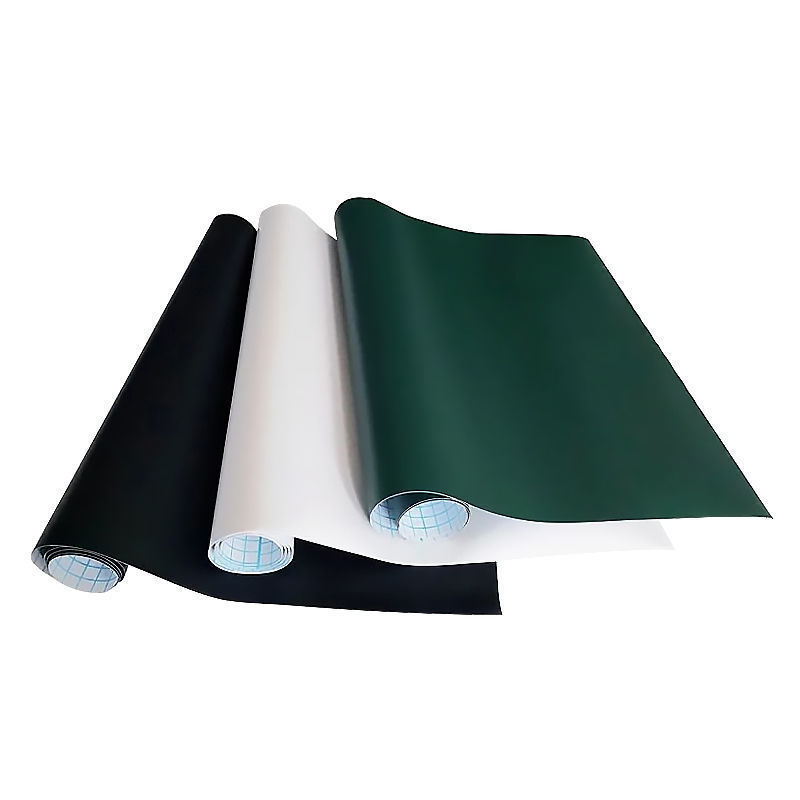
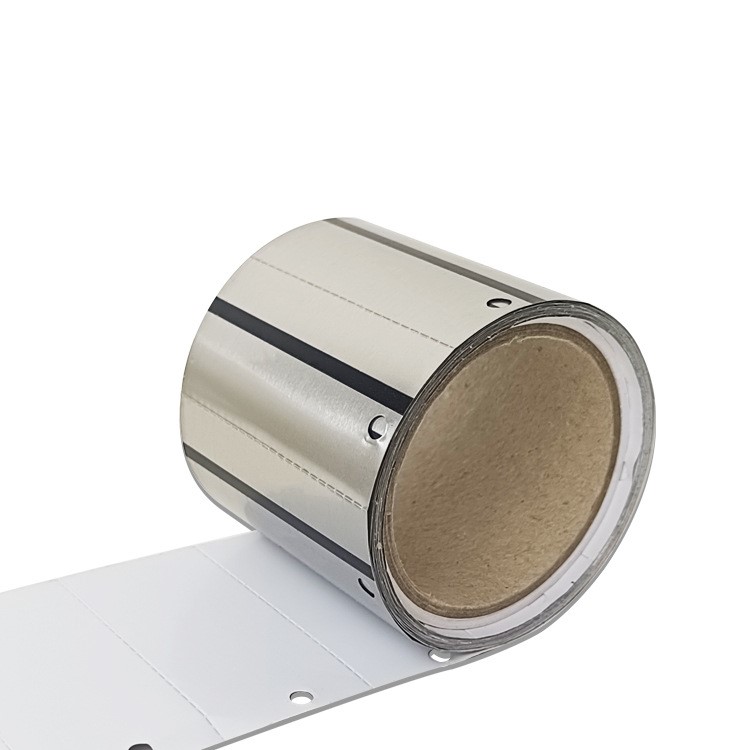
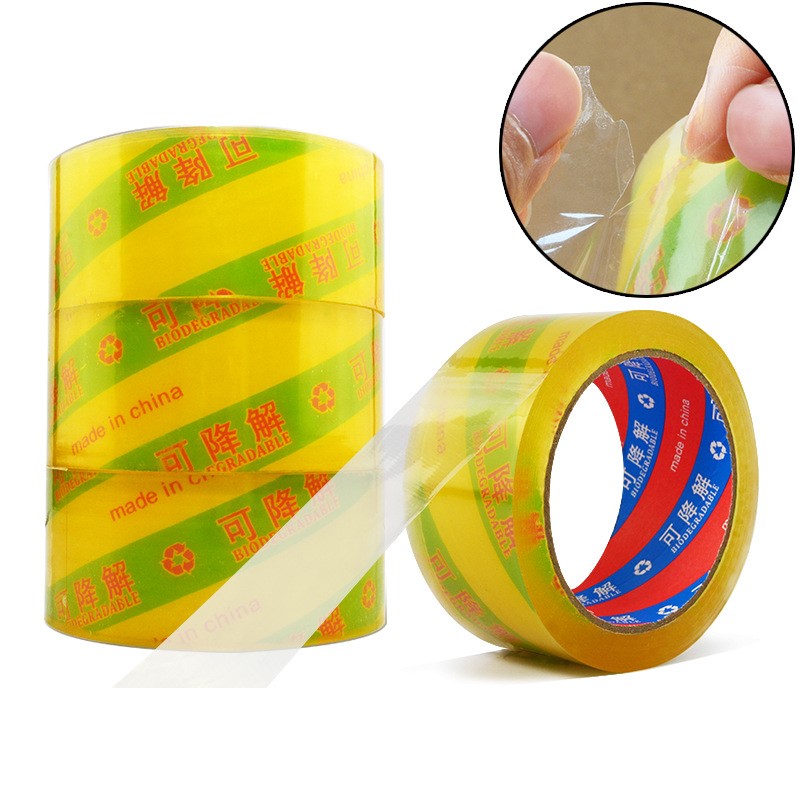
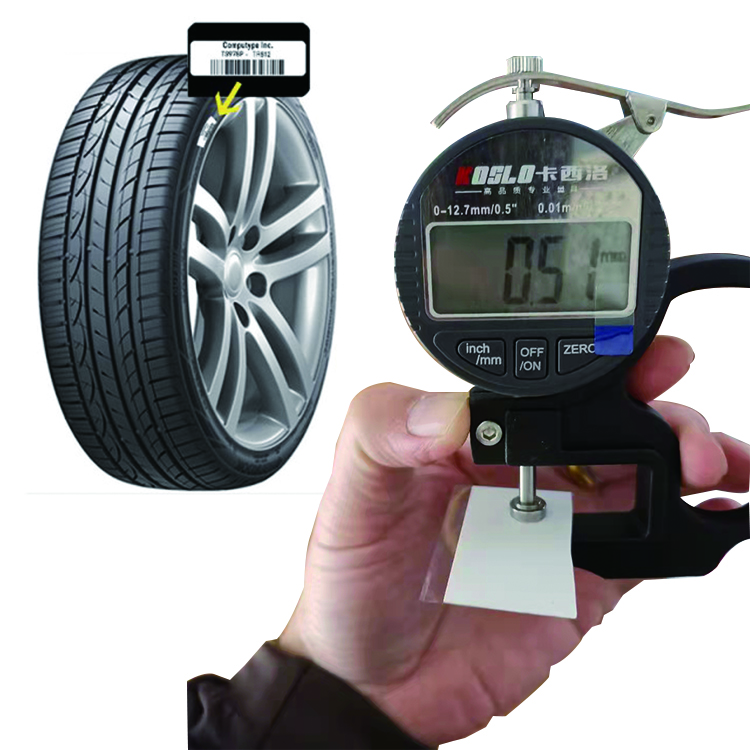
This site is protected by reCAPTCHA and the Google Privacy Policy and Terms of Service apply.